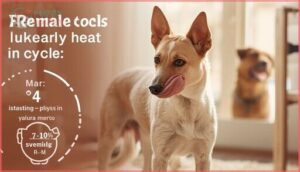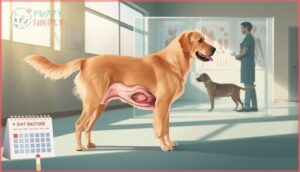This site is supported by our readers. We may earn a commission, at no cost to you, if you purchase through links.
Your dog’s behavior shifts overnight—she’s restless, her vulva looks swollen, and suddenly every male dog in the neighborhood seems to know something you don’t. If you’ve noticed these changes, your female dog has likely entered her heat cycle, a natural reproductive phase that most dog owners will navigate multiple times throughout their pet’s life.
The entire heat cycle usually lasts two to three weeks, though individual dogs can vary from as short as a week and a half to as long as four weeks.
Understanding how long a female dog stays in heat, what happens during each stage, and how to manage this period effectively will help you keep your dog comfortable, prevent unwanted pregnancies, and watch for potential health complications that can arise during this hormonally active time.
Table Of Contents
- Key Takeaways
- How Long Does a Female Dog Stay in Heat?
- What Are The Stages of The Dog Heat Cycle?
- What Are The Signs a Dog is in Heat?
- How Often Do Female Dogs Go Into Heat?
- What Factors Affect Heat Cycle Length?
- When is a Dog Fertile During Heat?
- How to Care for a Dog in Heat
- What Are Common Health Risks During Heat?
- How Can Unwanted Pregnancy Be Prevented?
- Does Heat Cycle Change With Age?
- Frequently Asked Questions (FAQs)
- How long does a dog’s heat cycle last?
- How long does a female dog stay in heat?
- What is a female dog’s heat cycle?
- How long do small breed dogs stay in heat?
- When do dogs go into heat?
- How long does a dog stay in heat after ovulation?
- How do I get my female dog out of heat?
- What are the 4 stages of a dog in heat?
- How long can a female dog bleed while in heat?
- How long does a dog heat cycle last?
- Conclusion
Key Takeaways
- Your female dog will typically stay in heat for two to three weeks, though cycles can range from as short as a week and a half to as long as four weeks depending on individual factors like breed, size, and age.
- The fertile window occurs during the estrus stage—usually 7 to 10 days after bleeding starts—and lasts only 2 to 3 days when eggs remain viable, making precise timing critical for preventing unwanted pregnancy.
- Intact female dogs face escalating health risks with age, including a 23% chance of developing pyometra by age 10 and significantly increased mammary tumor risk, both of which can be eliminated through spaying.
- Managing a dog in heat requires strict physical separation from male dogs using double barriers, consistent hygiene practices with frequent diaper changes, and vigilant monitoring since even brief unsupervised contact can result in pregnancy.
How Long Does a Female Dog Stay in Heat?
Most female dogs stay in heat for about two to three weeks, though the exact timing varies. Some dogs wrap up in as little as a week and a half, while others stretch closer to four weeks.
Understanding the typical range, what influences these differences, and how each stage unfolds will help you know what to expect.
Typical Heat Duration Range
Understanding heat cycle length helps you plan and protect your dog during her fertile period. Most unspayed females show visible signs of heat for about 2 to 3 weeks per cycle.
Here’s what the typical dog heat cycle timeline looks like:
- Total heat duration: 12 to 20 days of noticeable symptoms
- Proestrus timing: 7 to 10 days with discharge and swelling
- Estrus duration: 9 days on average when mating is accepted
- Full estrus cycle: Repeats roughly every 6 months
To better manage your dog’s heat cycle, it’s vital to understand the dog heat stages.
Variations by Individual Dog
While general timelines provide a useful reference, your dog’s heat cycle follows her own unique pattern. Individual cycles can vary widely due to genetic variability and hormonal fluctuations. Some females show heat signs for just 12 days, while others remain in estrus for three full weeks.
Breed differences, health factors, and even within-dog variation between cycles mean your dog’s reproductive health timeline is distinctly her own. Understanding the estrus cycle manipulation can help dog owners better manage their pet’s reproductive health.
Cycle Stage Breakdown
The complete heat cycle in your dog breaks down into four distinct stages driven by hormone shifts. Proestrus lasts 6 to 11 days, marked by bloody discharge and vulvar swelling. Estrus follows for roughly 7 days—your dog’s fertile window when discharge lightens and she accepts mating. Diestrus spans about 60 days as progesterone rises, then anestrus brings 4 to 6 months of rest before the reproductive cycle repeats.
What Are The Stages of The Dog Heat Cycle?
Your dog’s heat cycle isn’t just one continuous phase—it’s actually divided into four distinct stages, each with its own timeline and characteristics. Understanding these stages helps you anticipate what’s coming and recognize where your dog is in the process.
Let’s break down each phase so you know exactly what to expect.
Proestrus Stage
Proestrus marks the beginning of your dog’s heat cycle, lasting an average of 7–10 days but sometimes stretching up to 4 weeks. Rising estrogen levels trigger vulvar swelling and a blood-tinged discharge. Your female will attract males but won’t permit mating yet—she’s not fertile during this stage.
Watch for increased restlessness, frequent licking, and urine marking as hormone levels climb.
Estrus Stage
Estrus is when your dog becomes receptive—she’ll stand firmly, flag her tail to the side, and permit mating. This fertile window averages 9 days but can span 3–21 days.
Vaginal discharge lightens to straw-colored, and progesterone rises above 2 ng/ml, signaling ovulation within 24 hours.
Estrus symptoms include softer vulvar tissue and heightened male attraction, making heat cycle management and separation essential for canine reproduction control.
Diestrus Stage
Diestrus follows ovulation, lasting approximately 60 days as progesterone peaks at 25–90 ng/ml to support pregnancy or pseudopregnancy. The corpus luteum dominates this luteal phase, driving uterine changes that prepare for implantation.
Your dog’s vulva shrinks, discharge ceases, and male interest fades. Watch for pseudopregnancy signs—nesting, mammary swelling—and pyometra risk, which affects up to 25% of unspayed females, making reproductive health monitoring essential.
Anestrus Stage
Reproductive rest, or anestrus, is the longest phase of a dog’s heat cycle, typically lasting 3–4 months but extending to 4–6 months in large breeds. During this time, hormone levels drop to baseline, halting estrus and fertility.
Some dogs cycle twice yearly, resulting in shorter anestrus durations, while giant breeds may rest for 6+ months between heats. Cycle variations are normal, influenced by factors such as breed size, age, and genetics, which collectively impact reproductive rest periods and canine fertility patterns.
What Are The Signs a Dog is in Heat?
Recognizing when your dog is in heat isn’t always straightforward, especially if this is her first cycle. The signs can range from obvious physical changes to subtle shifts in behavior that you mightn’t immediately connect to her reproductive cycle.
Let’s walk through the three main categories of symptoms you’ll want to watch for.
Physical Symptoms
Your dog’s body sends clear signals when she enters her heat cycle. Watch for these three hallmark physical changes:
- Vulvar swelling — The vulva enlarges noticeably, often 3–5 days before bloody discharge appears
- Vaginal discharge — Blood-tinged fluid emerges during proestrus, shifting to lighter straw-colored secretions as estrus approaches
- Mammary changes — Nipples may swell from hormonal fluctuations, though this develops later in the cycle
Skin irritation around the vulvar area can occur from constant moisture exposure.
Behavioral Changes
Hormonal changes reshape your dog’s behavior just as dramatically as her physical appearance. Around 60–70% of intact females show restlessness patterns—pacing, whining, and difficulty settling—especially during proestrus and estrus.
You’ll notice social behavior shifts too: roughly 60% become more affectionate and clingy, while 20–30% display increased anxiety triggers like panting or mild irritability. Some bitches even exhibit brief aggression factors toward household pets, though most behavioral fluctuations resolve within 1–3 weeks.
Attraction of Male Dogs
Male dogs detect pheromones from your bitch’s reproductive cycle at remarkable distances—some intact males will travel kilometers following scent trails left in urine and vulvar secretions. You’ll notice increased marking, persistent whining, decreased appetite, and escape attempts from nearby males during her fertility cycle.
Even neutered dogs may show interest, though their sexual arousal and canine mating behaviors remain less intense than intact counterparts.
How Often Do Female Dogs Go Into Heat?
The frequency of your dog’s heat cycles isn’t as predictable as you might think. Most female dogs go into heat about twice a year, but this timing can shift based on several factors you’ll want to understand.
Let’s look at what influences how often your dog will cycle and what you can expect based on her unique characteristics.
Average Frequency of Heat Cycles
Most female dogs go through their reproductive cycle approximately twice per year, with heat cycle patterns spacing out every 5 to 7 months on average. Understanding your dog’s estrus timing helps you plan for proper care and prevents unintended pregnancies during fertility windows.
Key cycle frequency facts:
- Biannual pattern: Your dog will usually enter heat twice yearly, roughly six months apart
- Individual variation: Some dogs cycle regularly every 5 months, while others stretch to 11 months between heats
- Abnormal intervals: Cycles shorter than 4 months or longer than 12 months warrant veterinary evaluation for reproductive health
Factors Influencing Cycle Frequency
Several forces shape how often your dog cycles through estrus. Hormone levels play the starring role, but genetic factors passed down through breeding lines matter too. Environmental influences like stress or housing conditions can delay heats, while nutritional effects on body condition alter gonadotropin secretion.
Breeding practices and artificial hormonal interventions modify natural canine fertility patterns, sometimes extending intervals between cycles or creating health trade-offs you’ll want to discuss with your veterinarian.
Breed and Age Differences
Those influences work differently depending on your dog’s profile. Breed variations and age factors create distinct estrus patterns you’ll need to track:
- Small-breed females often cycle three times yearly, hitting first heat around 6–10 months and maintaining frequent intervals throughout life.
- Large and giant breeds may wait until 18–24 months for initial estrus, then cycle only once or twice annually.
- Senior dogs show lengthening gaps between heats, though they don’t experience menopause—reproductive health risks climb with each passing year.
What Factors Affect Heat Cycle Length?
Not every dog follows the same timeline during their heat cycles. Several biological and environmental factors can influence how long your dog stays in heat and how often these cycles occur.
Let’s look at the key elements that play a role in determining your dog’s individual heat cycle pattern.
Breed and Size
Your dog’s breed and size play a surprisingly large role in how often she cycles. Small breeds like Chihuahuas often go into heat every 4–6 months, while giant breeds such as Great Danes may cycle just once yearly. This genetic influence on the dog heat cycle stems from body type—smaller dogs mature faster, shortening anestrus and increasing heat frequency, directly affecting canine breeding and fertility planning.
| Size Category | Heat Frequency | Interestrous Interval |
|---|---|---|
| Small/Toy Breeds | 2–3 times/year | 4–6 months |
| Medium Breeds | ~2 times/year | 6–7 months |
| Large/Giant Breeds | 1–2 times/year | 10–12 months |
Understanding these breed variations helps you anticipate your female dog’s estrus pattern and aids effective dog heat cycle management for dog reproductive health.
Age and Maturity
Your dog’s age fundamentally shapes her heat cycle from the very start. Puberty onset varies widely—smaller breeds may enter their first estrus around 6 months, while giant breeds often wait until 18–24 months as their growth rates dictate maturity signs.
- Early cycles: Young dogs show irregular intervals for up to 2 years before establishing consistent patterns
- Prime years: Adult female dog cycles stabilize around 6–7 months apart, optimizing canine fertility
- Senior shifts: Aging lengthens intervals beyond 12 months, complicating dog heat cycle management and increasing spaying considerations
Health and Hormonal Status
Hormone regulation plays a crucial role in shaping every aspect of a dog’s estrus timing and safety. Thyroid function fluctuates with estrogen levels, as TT4 rises during estrus while estradiol peaks just before, creating shifts that can mask hypothyroidism. Reproductive aging and chronic progesterone exposure degrade uterine health, triggering pyometra in 19–25% of intact females by age 10 and raising mammary tumor risk after repeated canine estrous cycles.
Hormonal changes during heat not only affect fertility but can also mask thyroid disease and increase pyometra risk by 25% in older intact dogs
| Hormonal Factor | Effect on Cycle | Health Impact |
|---|---|---|
| Estrogen levels | Peak 1–2 days before estrus, trigger ovulation | High estrogen correlates with lower TT4 |
| Progesterone dominance | Rises to 15–90 ng/mL in diestrus, lasts 8–10 weeks | Suppresses uterine immunity, increases pyometra risk |
| Thyroid (TT4) | Elevated during estrus and diestrus | Hormonal changes in dogs can mimic thyroid disease |
| Endocrine Balance | Stabilizes in prime years, dysregulates with age | Reproductive aging reduces fertility, raises neoplasia |
| Exogenous hormones | Progestins delay heat 4–6 months | Increase obesity, diabetes, and reproductive health complications |
Hormonal fluctuations during a dog’s reproductive cycle have significant implications for their overall health. The interplay between estrogen, progesterone, and thyroid function can lead to various complications, including pyometra, mammary tumors, and thyroid disease. As dogs age, endocrine dysregulation further exacerbates these risks, underscoring the importance of monitoring hormonal changes and maintaining reproductive health.
When is a Dog Fertile During Heat?
Your dog isn’t fertile during her entire heat cycle—there’s a specific window when pregnancy can occur, and knowing when that’s gives you real control over the situation. The timing matters more than most people realize, and missing those key signs can lead to an unplanned litter.
Let’s break down exactly when your dog can get pregnant, what to watch for, and how to protect her if breeding isn’t in your plans.
Identifying The Fertile Window
You can’t rely on calendar dates alone to pinpoint your dog’s fertile window. Fertility timing during the heat cycle hinges on ovulation detection, which generally occurs 7–10 days after bleeding begins in proestrus.
Hormone testing—especially progesterone assays—offers the most accurate breeding planning tool, identifying the narrow 2–3 day period when eggs remain viable and conception is most likely.
Signs of Peak Fertility
Peak fertility isn’t a guessing game when you know what to watch for. Your female dog’s body broadcasts clear heat symptoms as her fertile window opens.
- Vulvar swelling reaches its maximum, then softens—paired with straw-colored vaginal discharge instead of bright red blood
- Behavioral cues shift dramatically—she’ll flag her tail to the side and actively seek male attention, responding to pheromones
- Hormone levels spike—progesterone climbs to 5–15 ng/ml at ovulation, confirming fertility signs through testing
These combined fertility signs guide precise heat cycle management and breeding decisions.
Risks of Unplanned Pregnancy
Unplanned breeding during your dog’s fertile window unleashes serious consequences beyond simply raising puppies. Research shows maternal risks spike dramatically—dystocia affects 8.3% of unintended matings, while nearly half of pups from unplanned pregnancies arrive stillborn compared to 26% in managed breeding. Reproductive health for your unspayed female deteriorates with every cycle, compounding canine welfare concerns and straining animal shelters nationwide.
| Complication | Risk in Unplanned Breeding |
|---|---|
| Dystocia (difficult labor) | 8.3% of accidental matings |
| Stillborn puppies | 46.6% vs. 26.4% in planned litters |
| Emergency C-section mortality | Up to 20% for puppies, 1% for dams |
| Shelter euthanasia | 5+ million dogs annually from surplus litters |
How to Care for a Dog in Heat
Caring for a dog in heat doesn’t have to be overwhelming once you know what to expect. Your main priorities will be keeping her clean and comfortable, minimizing her stress, and preventing any accidental breeding.
Here’s what you need to focus on during this three-week window.
Managing Discharge and Hygiene
Managing discharge during estrus means balancing cleanliness with your dog’s comfort. You’ll want to address vulvar care promptly while protecting your home from staining:
- Change dog diapers every 3–4 hours during heavy discharge days to prevent skin irritation and leakage
- Gently wipe the vulvar area with unscented pet-safe wipes once or twice daily
- Wash bedding every 1–2 days during peak bleeding to limit bacterial buildup
- Use enzymatic cleaners on floors and furniture to eliminate organic residues and odor
- Confine your dog to easily cleaned spaces with washable flooring when unsupervised
If vaginal discharge becomes foul-smelling or greenish, contact your veterinarian—abnormal discharge can signal infection rather than normal estrus bleeding.
Reducing Stress and Anxiety
Beyond hygiene, hormonal surges during heat often heighten anxiety in your female dog. Daily aerobic exercise for 20–30 minutes can cut stress-related pacing and barking by roughly 40%.
Pair physical activity with mental stimulation—puzzle feeders, scent games—to reduce restlessness. Create a quiet retreat with familiar bedding, and maintain predictable routines.
If anxiety persists despite environmental management and behavioral techniques, consult your veterinarian about pharmacologic interventions.
Keeping Dogs Separated
While environmental enrichment calms the female, separation techniques become your frontline defense against accidental mating. Even seconds of unsupervised contact can result in pregnancy. Implement these barrier methods:
- Use double barriers—two closed doors or a door plus baby gate—because motivated male dogs breach single obstacles.
- Rotate access with written schedules: only one dog loose at a time while the other remains confined.
- Practice crate training in separate rooms, sized so each dog can stand, turn, and lie down comfortably.
- Maintain leash control during all outdoor toilet breaks, even in fenced yards, to prevent escapes and roaming males.
- Board one dog temporarily if your home can’t support isolation strategies for the full 2–3 week estrus period.
Instruct visitors—especially children—never to open doors for “hellos.” Spayed females don’t trigger this urgency in male dogs, but intact pairs demand vigilance. Check latches at every rotation; handling errors cause most unplanned pregnancies.
For multi-dog households, this disciplined approach to animal breeding prevention protects both dog behavior and health outcomes.
What Are Common Health Risks During Heat?
While heat cycles are a natural part of your dog’s life, they can sometimes open the door to serious health complications. Understanding these risks helps you spot warning signs early and take action before minor issues escalate.
Let’s look at the three main health concerns you should watch for during your dog’s heat cycle.
Pyometra and Uterine Infections
Pyometra, a life-threatening uterine infection driven by bacterial contamination, develops in up to 25% of unspayed dogs by age ten—usually two to eight weeks after heat ends.
You’ll notice lethargy, excessive thirst, or purulent discharge as pyometra symptoms emerge. Sepsis prevention demands immediate veterinary care for dogs showing these signs.
Spaying remains your strongest tool for pyometra prevention and safeguarding long-term reproductive health in dogs.
False Pregnancy
False pregnancy, or pseudopregnancy, affects up to 75% of certain breeds after heat when prolactin levels surge as progesterone drops. You’ll see swollen nipples, vaginal discharge, nesting behavior, and milk production without actual pet pregnancy.
Three common pseudopregnancy causes include:
- Normal hormonal shifts during diestrus
- Spaying during high-progesterone phases
- Individual prolactin sensitivity variations
Hormone therapy with dopamine agonists resolves most cases within days.
Hormonal Imbalances
Dysregulation of progesterone, estrogen, and prolactin can disrupt uterine health and cycle timing. Your dog’s progesterone levels peak around three to four weeks into diestrus, then gradually decline—any deviation from this pattern can trigger endometrial thickening or irregular cycles.
Luteinizing hormone spikes before ovulation, but chronic imbalances compromise fertility and increase infection risk, making proper endocrinology monitoring essential for intact females.
How Can Unwanted Pregnancy Be Prevented?
If your female dog isn’t spayed, preventing unwanted pregnancy requires vigilance during her heat cycle. The good news is that you have several proven methods at your disposal, from permanent surgical options to practical day-to-day management strategies.
Let’s look at the most effective approaches to keep your dog safe and pregnancy-free.
Spaying and Its Benefits
Spaying offers the most reliable shield against unwanted pregnancy while dramatically reducing your dog’s risk of mammary tumors. Studies show females spayed before their first heat face under 1% risk versus 26% when sterilized after two cycles.
The spay procedure also eliminates pyometra, a life-threatening uterine infection affecting up to 25% of intact dogs.
Beyond individual health outcomes, spaying and neutering contribute markedly to population control efforts nationwide.
Physical Separation Methods
Beyond spaying, careful containment stands as your frontline defense during those critical 2–3 weeks. You’ll need solid doors, sturdy gates rated for large breeds, and secure fencing that blocks gaps under 10 cm—motivated males can squeeze through surprisingly tight spaces or clear 120 cm barriers when drawn by a female dog in heat.
- Indoor barriers: Use double setups (door plus tall gate) to prevent determined dogs from jumping or pushing through single obstacles
- Secure fencing: Check vertical panels for climbing risks and reinforce weak points in garden gates with locking mechanisms
- Kennel designs: Maintain separate housing blocks that minimize visual and auditory cues between intact males and in-heat females
- Supervised rotation: Schedule strictly segregated time so only one dog roams loose while the other remains securely confined
- Gate systems: Install double-gate entries or pressure-mounted barriers as buffer zones between rooms during the vulva swelling phase
Use of Dog Diapers and Leashes
Dog diapers offer modest vulva protection and help with pet hygiene by containing bloody discharge, but they’re not reliable contraception—determined males can rip or bypass them.
Pair diapers indoors with strict leash training outdoors during the entire heat cycle, keeping walks short and controlled. This heat management combo reduces mess and limits scent spread, yet only spaying truly safeguards against unwanted breeding and long-term dog health issues.
Does Heat Cycle Change With Age?
Your dog’s heat cycle doesn’t stop as she gets older, but it does shift in ways you’ll want to understand. Senior dogs face different risks and physical changes that make each cycle more complicated than when they were younger.
Here’s what happens to your dog’s reproductive cycle as the years go by and what you need to watch for.
Heat Cycles in Senior Dogs
Unlike humans, your female dog won’t experience menopause—canine estrous cycles continue throughout her life. However, senior health risks escalate as she ages. After around 7–8 years, you’ll likely notice heat cycle irregularities: longer gaps between heats, subtle or “silent” signs, and reduced age-related fertility.
Even older dogs that aren’t spayed remain reproductively active, though conception rates drop and uterine disease management becomes critical.
Health Considerations for Older Dogs
Intact females over eight face dramatically higher risks as they age—spayed dogs avoid these dangers entirely. Your older girl’s vulnerability increases with every cycle:
- Pyometra strikes roughly 23% of intact females by age 10, often requiring emergency surgery and carrying about 10% mortality if untreated.
- Mammary tumors constitute 53% of malignancies in unspayed dogs, with half being aggressive cancers.
- Surgical complications escalate when emergency procedures become necessary in geriatric management.
Veterinary guidance emphasizes proactive canine fertility decisions, since senior dog care becomes exponentially more complex without earlier spaying.
Discuss older dog risks and veterinary care options with your vet—dog health and wellness depend on informed aging health planning.
Long-Term Cycle Management
Managing your girl’s cycles over her lifetime requires methodical cycle monitoring to catch health risks early. Track each proestrus start, diestrus length, and anestrus interval—patterns shifting beyond the typical six-month rhythm signal trouble.
Reproductive planning isn’t optional: spaying before middle age prevents pyometra and tumors, while keeping intact seniors demands vigilant fertility management and senior care protocols customized to her evolving needs.
Frequently Asked Questions (FAQs)
How long does a dog’s heat cycle last?
Your female companion’s heat cycle usually lasts 2 to 3 weeks, though it can range from as brief as 2 days to as long as 21 days, depending on breed and individual variation.
How long does a female dog stay in heat?
Your dog will usually stay in heat for 2 to 3 weeks per cycle. This visible estrous cycle combines proestrus and estrus stages, during which you’ll notice vulvar swelling, discharge, and behavioral changes.
What is a female dog’s heat cycle?
Your dog’s heat cycle—more precisely called the estrous cycle—is her reproductive rhythm, cycling through four distinct stages: proestrus, estrus, diestrus, and anestrus, each driven by shifting hormones that control fertility and breeding readiness.
How long do small breed dogs stay in heat?
Regarding canine reproductive health, small breeds don’t cut corners—they usually stay in heat for 14 to 21 days per cycle, matching larger dogs in heat cycle duration despite their petite size.
When do dogs go into heat?
Most female dogs experience their first heat cycle between 6 and 12 months of age, though breed factors and size play a major role—smaller breeds often reach canine puberty earlier than larger ones.
How long does a dog stay in heat after ovulation?
After ovulation, your dog usually stays in heat for about 7 to 8 days. This post-ovulation period marks the tail end of the fertility window before she transitions into diestrus.
How do I get my female dog out of heat?
You can’t stop a heat cycle once it starts—spaying is the only permanent solution.
Medical interventions like hormone therapy exist but carry significant health risks.
Focus on managing symptoms through behavioral strategies until the cycle naturally concludes.
What are the 4 stages of a dog in heat?
Your female dog’s reproductive health follows four distinct phases: proestrus (preparation), estrus (fertile window with ovulation), diestrus (post-fertile hormone regulation), and anestrus (rest period).
Understanding these heat symptoms helps manage canine behavior throughout cycle length variations.
How long can a female dog bleed while in heat?
Wondering how long that messy discharge will last? Your female dog usually bleeds for 7 to 10 days during proestrus, though some may spot for just 3 days while others continue bleeding throughout the estrous cycle.
How long does a dog heat cycle last?
Your dog’s complete heat cycle lasts about 6 to 7 months from start to finish. The visible “in heat” phase spans roughly 2 to 3 weeks, while diestrus and anestrus account for the remaining time between cycles.
Conclusion
Ironically, the moment you truly understand how long a female dog stays in heat—those two to three weeks that feel like an eternity—you’ll realize your real challenge wasn’t the timeline at all.
It was managing the chaos: neighborhood suitors plotting escape routes, your furniture wearing protective gear, and your sanity hanging by a thread.
Armed with this knowledge, you’re no longer guessing. You’re prepared, vigilant, and ready to navigate each cycle with confidence and control.





















Valerie Bullard
May 30, 2022 at 04:27 PM
My dog is bleeding hard this time she never did this.
Jane
June 16, 2021 at 06:43 PM
I never got a response. Lots of stages but I needed to know the days from beginning to end.